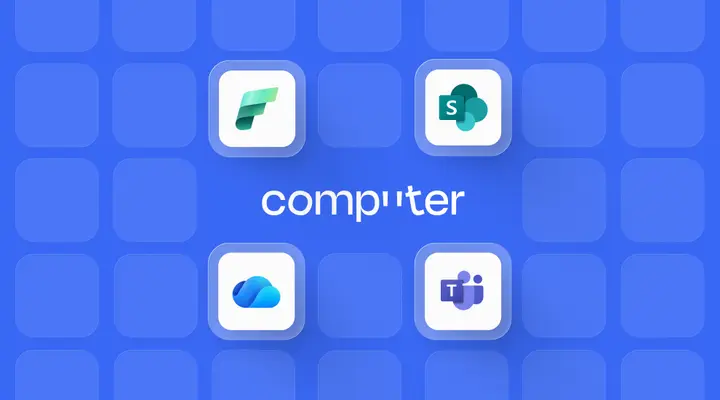Last week at the Gartner IT Symposium in Barcelona, I had the privilege of meeting dozens of CxOs – CIOs, CTOs, CDOs, and Chief Transformation Officers – representing industries as diverse as banking, telecom, healthcare, and software.
Every conversation was different. Every conclusion was the same:
“We’ve scaled IT, modernized applications, secured our infrastructure – but our organization’s knowledge is stuck in silos.”
This perfectly captures the paradox of the SaaS era.
SaaS gave us scale, but also fragmentation
Over the last decade, SaaS has helped organizations scale IT, build more resilient applications, strengthen security, and reduce costs.
We’ve built specialized tools for every function – from Salesforce in Sales to Workday in HR, from ServiceNow in IT to Coupa in Procurement.
But with that specialization came fragmentation.
- Each function operates in its own stack, generating valuable insights that rarely connect.
- Data sits scattered across systems that weren’t designed to talk to one another.
- Teams apply their own contextual bias to the same metrics.
And what should be a single source of truth becomes a patchwork of partial truths.
As one CIO told me,
“Our challenge isn’t lack of data – it’s too much data, interpreted differently by every team.”
It’s not a data problem anymore – it’s an intelligence alignment problem.
Computer – your AI teammate
That’s precisely why we built Computer by DevRev.
Computer is your AI teammate.
It’s not another chatbot – it connects your entire IT stack, so you can talk to your tools, ask questions across systems, and act instantly.
It bridges front and back offices, unifies data, and turns conversations into coordinated action.
You can ask it:
“Computer, show me the top customer pain points driving support tickets and link them to product issues.”
“Summarize our Q4 budget variance and create follow-up tasks for Finance.”
“List all vendor contracts expiring this quarter and share compliance risks with Legal.”
“Pull engagement trends from the last three HR pulse surveys and highlight key insights.”
But Computer doesn’t just reply, it acts.
It updates records, routes approvals,triggers workflows and logs decisions across systems – all while respecting your permissions and compliance rules.
It’s the digital teammate every CxO has been waiting for – one that understands, reasons, and executes across the entire enterprise landscape.
The only way to apply AI is by integrating everything around us
If there’s one conclusion I drew from Barcelona, it’s this:
The only way to apply AI meaningfully is by integrating everything around us.
AI alone isn’t enough.
Plugging generative models into a single tool may create local efficiencies, but it doesn’t redefine work. The real breakthrough happens when we connect all tools, data, and workflows – when the enterprise itself becomes the context.
That’s what Computer does.
It unifies front-office and back-office – into a shared language of intelligence and action.
Front-office: where customer experience and revenue intersect
Front-office teams in Product, Support, and Customer Success live closest to the customer – yet see a fragmented view across disconnected systems.
With Computer, those walls disappear.
- Product & Engineering ask: “Show support tickets referencing the new feature rollout and tag feedback as potential enhancements.”
Computer instantly connects support insights to the product backlog.
- Support asks: “Identify customers with repeat issues in the last 30 days and alert Customer Success.”
This enables proactive engagement before dissatisfaction escalates.
- Customer Success says: “Summarize renewal risks for accounts with unresolved technical escalations.”
Computer cross-references CRM, tickets, and NPS to surface what matters.
Back-office: the operational brain of the enterprise
If the front office is where value is delivered, the back office is where it’s sustained.
HR, Finance, Legal, IT, and Operations depend on accurate, timely data — yet are buried under manual reconciliation, approvals, and disconnected systems.
With Computer, they gain clarity, consistency, and speed.
- HR:“Computer, summarize feedback from onboarding surveys and highlight the top three areas for improvement.”It aggregates data from forms, emails, and internal systems – delivering actionable insights.
- Finance:“Computer, list departments exceeding budget forecasts and create a task for variance review.”Financial control becomes continuous, not just monthly
- Legal:“Computer, show contracts that include data-processing clauses and notify compliance if any are due for renewal.”Risk management becomes more proactive and not reactive.
- IT and Operations:“Computer, correlate last week’s incidents with deployment activity and flag potential root causes.”Suddenly, incident management becomes intelligent – not reactive.
These are back-office breakthroughs – when administrative friction disappears, operational intelligence emerges.
A teammate you can trust
Just like a human colleague, Computer understands boundaries. It inherits your permissions, adheres to your governance, and maintains your security posture across systems.
Every action is traceable. Every query is contextual. Every integration respects your organizational rules. That’s why we call it a teammate – not a tool. It operates within your culture of trust.
From fragmentation to unified intelligence
At Gartner, every CxO I met acknowledged the same shift:
We’ve optimized individual functions – now it’s time to connect the enterprise as a whole. Computer represents the next stage of that evolution.
It turns a fragmented organization into an integrated system of intelligence, where data flows freely, insights are shared instantly, and actions are taken confidently.
The outcome?
- Faster, better decisions.
- Happier, more productive employees.
- Seamless, personalized customer experiences.
- And a unified operating model built on context, not chaos.
Where does it end?
That’s the exciting part – it doesn’t.
From front-office to back-office, from engineering to HR, every team has something to gain. The more we connect, the more intelligent and autonomous the enterprise becomes.
A world where you talk to your business – and your business talks back is no longer futuristic. It’s happening now.
With Computer by DevRev, we’re redefining what work means – one conversation at a time.
Where does it end? Well, let’s try to find out together.



